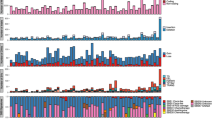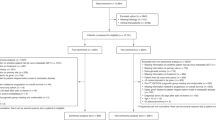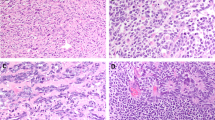Abstract
We analysed 973 patients with stage I testicular tumours presenting between 1983 and 1994. The median ages at presentation for non-seminomatous germ cell tumour (teratoma) were 27 years, seminoma 36 years and combined tumour 33 years. These differences were statistically significant (Mann-Whitney P < 0.05), suggesting that combined tumours may have a separate natural history. We, therefore, analysed all stage I patients managed with surveillance (530 in total) post orchidectomy. The actuarial 5 year relapse-free survival and anatomical patterns of relapse were identical for non-seminomatous germ cell tumour (NSGCT) and combined tumour and both were statistically distinct from seminoma (P = 0.01, log-rank test, chi-square test P = 0.001). The association of seminoma within a histologically confirmed NSGCT has no influence on the clinical outcome.
This is a preview of subscription content, access via your institution
Access options
Subscribe to this journal
Receive 24 print issues and online access
$259.00 per year
only $10.79 per issue
Buy this article
- Purchase on SpringerLink
- Instant access to full article PDF
Prices may be subject to local taxes which are calculated during checkout
Similar content being viewed by others
Author information
Authors and Affiliations
Rights and permissions
About this article
Cite this article
Thomas, R., Dearnaley, D., Nicholls, J. et al. An analysis of surveillance for stage I combined teratoma - seminoma of the testis. Br J Cancer 74, 59–62 (1996). https://doi.org/10.1038/bjc.1996.315
Issue date:
DOI: https://doi.org/10.1038/bjc.1996.315



